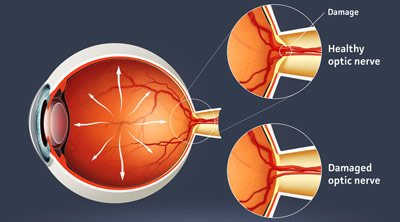What is Glaucoma?

Glaucoma is a disease in which your eye’s optic nerve becomes damaged due to buildup of increased intraocular pressure. Without early detection and treatment, this damage can result in serious vision loss and blindness. The damage caused by glaucoma is irreversible.
The dangerous levels of intraocular pressure occur because of an overabundance of fluid produced within your eye or because a blocked drainage channel (also known as trabecular meshwork).
Types of Glaucoma
There are two main types of Glaucoma: Chronic Open-Angle and Angle Closure Glaucoma.
Chronic Open-angle Glaucoma
Chronic open-angle glaucoma is the most common type of glaucoma. It occurs when your eye’s anterior chamber contains too much fluid (called aqueous) due to blocked drainage channels. Overproduction of the fluid and inability to properly drain causes the high buildup of pressure, which damages your optic nerve.
The symptoms of Chronic open-angle glaucoma are initially so gradual that they often go unnoticed.
Angle Closure Glaucoma
Angle closure glaucoma is a less common form of glaucoma. It is caused when your eye’s drainage become blocked mechanically and the buildup of fluid can cause a very rapid buildup of pressure.
The symptoms of angle closure glaucoma are more noticeable than open-angle because of their sudden potentially sudden onset. This type of glaucoma can develop much more rapidly and cause severe pain, vision loss, blurred vision, and nausea.
Women, farsighted individuals, and those of Asian and Hispanic ethnicity are more predisposed to Angle-closure glaucoma. If diagnosed early enough, it can be treated with a special laser called Laser Peripheral Iridotomy which can help prevent the more severe symptoms occurring.
Glaucoma Symptoms
The majority of glaucoma patients do not experience extreme warning signs or symptoms, so regular visits to your doctor are crucial for early detection. When glaucoma is detected and treated early, you have a much better chance of prevention effects like vision damage and blindness.
Anyone over the age of 40 should have a yearly eye exam in order to detect and prevent glaucoma.
Glaucoma Prevention & Treatment
This is one of the reasons annual eye exams by a competent eye doctor are recommended. The test of choice for diagnosing angle closure glaucoma is Gonioscopy.
Selective Laser Trabeculoplasty (SLT)
SLT is one of the safest and a very effective treatment for open-angle glaucoma. This is a pain-free 10-minute procedure that can lower eye pressure up to 30%. It can be used as a standalone treatment for glaucoma, to reduce a patient’s dependence on drops, or as an addition to drop therapy. In many cases, SLT can be performed instead of or as a replacement for drops. This in turn helps reduce the medication regimen burden for the patient.
Good candidates for SLT may include:
- Highly active individuals who don’t want to be burdened by drops
- Patients who are allergic or intolerant to drops or want to avoid their side effects
- Patients with arthritis who have trouble administering eye drops
- Patients for whom eye drops have not been effective or are inadequate to control eye pressure
- Patients highly dependent on contact lenses for whom taking the contacts out to use drops creates an undue burden
Trabeculectomy
Traditional Trabeculectomy is a very detailed surgical procedure where an intricate opening is created through the sclera (white part of the eye) to allow fluid to drain between the surface layers of the eye and bypass the natural drain of the eye. This procedure carries more risk and is reserved for cases of glaucoma that are not responsive to less invasive treatments.
Glaucoma Tube Shunt Surgery
These procedures allow for a surgical device attached to a tube to be inserted in the eye under the surface layer (conjunctiva) of the eye in order to drain fluid from the eye. They carry less risk than Trabeculectomy but also do not lower eye pressure as much. Our glaucoma specialist can determine what is the best treatment plan for your glaucoma needs based on your unique situation.
Minimally Invasive Glaucoma Surgery (MIGS)
These surgeries include Trabeculotomy and the Xen and iStent implants for the treatment of glaucoma. These procedures represent the latest technological advances in the field of glaucoma. They function by bypassing the natural drainage system of the eye in one way or another. The benefit of these surgeries is they are less invasive than traditional glaucoma surgeries (such as Trabeculectomy or Tube Shunt Surgery) and have a much better safety profile.
Which Glaucoma Procedure is Right for You?
A consultation with your doctor, Houman Vosoghi, is needed to determine which procedure is appropriate for your type of glaucoma. Dr. Vosoghi is an experienced glaucoma specialist who specializes in the medical and surgical management of glaucoma. At ADV Vision, we are proud to offer the most extensive options and technological advances available in the field. Please call one of our locations in Santa Maria, Paso Robles, or San Luis Obispo, or schedule online today.









